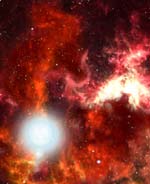
Image credit: Harvard CfA
New calculations by a pair of Harvard astronomers predict that the first “Sun-like” stars in the Universe were alone; devoid of planets or life. The very first generation of stars was hot and massive; they lived hard and died young. After they exploded as supernovae and seeded the Universe with heavier materials, other stars formed in stellar nurseries. The next generation of stars was probably similar in mass and composition to our own Sun, but there weren’t enough minerals to create rocky planets like the Earth. It took a succession of supernovae before there was enough heavy material that planets could form – probably 500 million to 2 billion years after the Big Bang.
To most people, the phrase “Sun-like star” calls to mind images of a friendly, warm yellow star accompanied by a retinue of planets possibly capable of nurturing life. But new calculations by Harvard astronomers Volker Bromm and Abraham Loeb (Harvard-Smithsonian Center for Astrophysics), which were announced today at the 203rd meeting of the American Astronomical Society in Atlanta, show that the first Sun-like stars were lonely orbs moving through a universe devoid of planets or life.
“The window for life opened sometime between 500 million and 2 billion years after the Big Bang” says Loeb. “Billions of years ago, the first low-mass stars were lonely places. The reason for that youthful solitude is embedded in the history of our universe.”
In The Beginning
The very first generation of stars were not at all like our Sun. They were white-hot, massive stars that were very short-lived. Burning for only a few million years, they collapsed and exploded as brilliant supernovae. Those very first stars began the seeding process in the universe, spreading vital elements like carbon and oxygen, which served as planetary building blocks.
“Previously, with Lars Hernquist and Naoki Yoshida (also at the CfA), I have simulated those first supernova explosions to calculate their evolution and how much heavy elements (elements heavier than hydrogen or helium) they produced,” says Bromm. “Now, in this work, Avi Loeb and I have determined that a single first-generation supernova could produce enough heavy elements to enable the first Sun-like stars to form.”
Bromm and Loeb showed that many second-generation stars had sizes, masses, and hence temperatures similar to our Sun. Those properties resulted from the cooling influence of carbon and oxygen when the stars formed. Even elemental abundances as low as one-ten thousandth those found in the Sun proved sufficient to allow smaller, low-mass stars like our Sun to be born.
Yet those same low abundances prohibited rocky planets from forming around those first Sun-like stars due to a lack of raw materials. Only as further generations of stars lived, died, and enriched the interstellar medium with heavy elements did the birth of planets, and life itself, become possible.
“Life is a recent phenomenon,” Loeb states unequivocally. “We know that it took many supernova explosions to make all the heavy elements we find here on Earth and in our Sun and our bodies.”
Recent observational evidence corroborates their finding. Studies of known extrasolar planets have found a strong correlation between the presence of planets and the abundance of heavy elements (“metals”) in their stars. That is, a star with higher metallicity and more heavy elements is more likely to possess planets. Conversely, the lower a star’s metallicity, the less likely it is to have planets.
“We’re now just beginning to investigate the metallicity threshold for planet formation, so it’s hard to say when exactly the window for life opened. But clearly, we’re fortunate that the metallicity of the matter that birthed our solar system was high enough for the Earth to form,” says Bromm. “We owe our existence in a very direct way to all the stars whose life and death preceded the formation of our Sun. And this process began right after the Big Bang with the very first stars. As the universe evolved, it progressively seeded itself with all the heavy elements necessary for planets and life to form. Thus, the evolution of the universe was a step-by-step process that resulted in a stable G-2 star capable of sustaining life. A star we call the Sun.”
Original Source: Harvard CfA News Release
